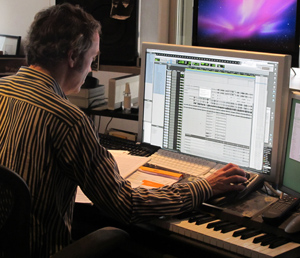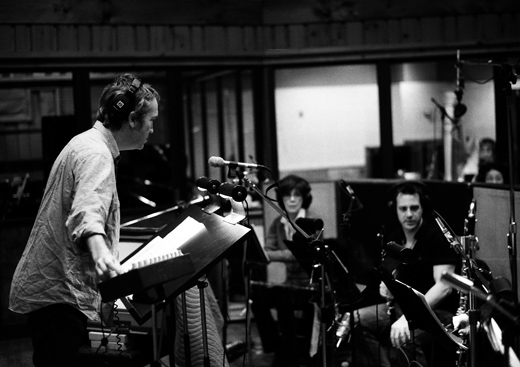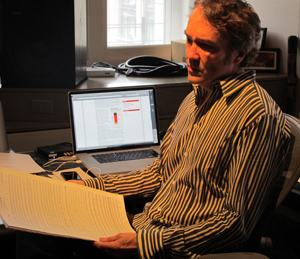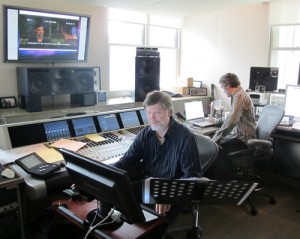Carter Burwell: On Scoring Twilight, Breaking Dawn & Other Works and Workflows
TRIBECA, MANHATTAN: It was like a scene out of a movie. Film score composer Carter Burwell wrote the final cue to The Twilight Saga: Breaking Dawn (Part I) at his piano in the country by the flickering light of an oil lamp.
“I was out at my place in Amagansett trying to finish up the score when Hurricane Irene hit and took out my power,” Burwell describes. “And it stayed out for four days. So I ended up writing the ending in this darkened, boarded up house.
“It was interesting and painful at the same time,” he says, with a laugh. “But it worked out.”
Being forced to compose the old-fashioned way is not as extreme an exercise for Burwell as it might be for another composer; he does write most of his themes at the piano. And the storm made a perfectly dark and romantic setting in which to conjure the final scene’s music, where Burwell reprises the soaring “Bella’s Lullaby” theme from the first Twilight, with liturgical sounds. Without spoiling the ending, it’s a heavy, most climactic scene.
We met up with Burwell during Breaking Dawn mixing sessions at his studio in Tribeca – by contrast a very well-lit, and highly technical environment. He’d been to record the score with an orchestra at Abbey Road, and was now working through the final stages with his longtime mixer Mike Farrow and his assistant Dean Parker.
Burwell may be best known for his work with the Coen Brothers, having scored every film they’ve made since Blood Simple (1984).
Between the Coen Brothers films – including, most recently True Grit – and a number of other standouts such as And The Band Played On, The Spanish Prisoner, Being John Malkovich, Adaptation, Where the Wild Things Are, Before the Devil Knows Your Dead, The Kids Are Alright and Mildred Pierce – Burwell’s scores span many eras of music, genres of film, and decades of critical acclaim.
Through it all, there is an authenticity to Burwell’s music that distinguishes his scores from the typical Hollywood fare. And as artists like Trent Reznor, Daft Punk, and Phoenix are signing onto score films nowadays, being an artist – living and working outside of the traditional movie studio system – may be coming more into favor. Directors want to collaborate with an artist. And Carter Burwell is an artist.
He took some time away from the mix to chat with SonicScoop about scoring for Twilight, and scoring in general…
Looking over your filmography, it seems like you haven’t scored a sequel before. You did the first Twilight but not the second and third. Can you tell me about how you came to do Breaking Dawn, the fourth of the Twilight films?
It’s true, I’ve never scored a sequel. But it’s pretty simple – I’ve worked with this director – Bill Condon – before [on Kinsey]. Bill wanted me to do the scores, but he wasn’t sure I would want to because they’re such huge melodramas, and that’s really very different than what I normally do. But he is entirely a pleasure to work with so I definitely wanted to do it.
When I was composing music for the first Twilight, I don’t think any of us knew that it would be that popular… that it would have this cultural resonance. There was such an enormous response. There have been thousands of emails people have written me, wanting to know how to play the themes on piano. And that has been really nice.
Oh that’s really cool – the fans genuinely engaging with the film’s score. Wow. So, in scoring this latest film, did you reprise any of those themes from the first? How did you continue that work you’d done on the first one, or did you not approach it like that at all?
Well, I did to some extent. The intervening two films were directed by different people and composed by different people and they didn’t use any of the musical themes from the first one.
But there’s this one love theme called “Bella’s Lullaby” that was on the Twilight soundtrack album and that’s the one that most people respond to from the first movie. And when I first talked to Bill Condon, he was excited to bring back “Bella’s Lullaby” – so we have brought it back, judiciously. There’s a hint of it here and there, and then in the last scene of this movie, we actually play it out. And it’s pretty dramatic.
Having worked with Bill Condon before, and having scored the first of this insanely successful series…how much actual direction did you get at the start of this project? How does it get started?
Well first we have the spotting session, where – on the one hand – we’re talking technically about where the music starts and ends. But honestly in a movie like this, it turns out that it really never ends. There’s 80 minutes of score in this movie, so the “where it starts and stops” conversation hardly entered into it. Really we spent that time talking about what is the point of this scene? What can the music say? What kind of theme can we use for this? There’s a lot of give and take in a conversation like that.
And for one thing, in a movie like this – there are (especially in the second half) a lot of special effects so when I’m looking at the screen, I won’t necessarily know what’s going on. So I have to depend on the director to say, ‘OK, here there are going to be wolves coming down this hill,’ because I cannot always tell what the important dramatic impact is when there are all these unfinished effects shots.
And from there, do you just start working? You have the job, so you’re not exactly pitching music…
That’s right. As soon as I talked to Bill and we agreed I would do this, I started thinking about themes and melodies. It’s a very different story than the first Twilight. In the first one, you begin in what seems like a normal environment for a high school girl and it becomes supernatural and very intense emotionally.
Here, by this point, there’s no pretense of anything being normal. So you begin in an already a heightened emotional state, with supernatural qualities and it just gets more so…so it’s much more melodramatic. And I knew that I would need a lot more thematic material than I did in the first one. In this movie, Edward and Bella get married. They’re becoming grownups. They face different challenges. The score has to take that into account. And so their music is really pretty different.
I began working as soon as I found out I had the job because I knew that it was a huge job and I wouldn’t have that much time to write all 80 minutes of music.
Did you tap any special musicians to play on this score? I know David Torn played a role on the first Twilight, contributing a lot of that characteristic electric guitar that worked so well. Since you are based in NY, it’s cool to think there’d be some NY influence on the sound of your stuff, just based on who you get to play on it.
Well, I like to think there is. This particular score is not as guitar oriented as the first. And that’s part of the tone that’s shifted from they’re being high-schoolers to them living an adult life. This score has a little more of the flavor of a traditional melodrama in the sense that we went to Abbey Road and recorded it with a larger orchestra than what we had on the first one. We did have, in London, this guitarist Leo Abrahams play on it – and he’s a very interesting guitarist.
Cool. What about the fact that Breaking Dawn is a two-parter? Knowing you’re also going to be scoring Part II, does where the story goes from here enter into the picture at all for you? When you’re thinking of these themes?
Well, I’ve read the script, but I haven’t seen any of Part II yet. But I did have to write a theme that Edward plays on camera in Part II. Bill wanted to echo the “Bella’s Lullaby” scene from the first Twilight in the last part, and so I had to write a lullaby for that well in advance so Rob Pattinson could learn the fingering – he’s a musician and prides himself on being able to do that.
So we know that’s an important part of Part II. And we hint at that theme in Part I. But honestly, it was quite a challenge for me to get my head around the 80 minutes of music for this one. My scores are usually half that. So I didn’t give very much thought to Part II while I was doing Part I.
That brings me to my next question – when you’re writing, how do you budget your time? Reading the project notes on your website, I’ve been so amazed by how quickly you seem to write and record these scores. And some of the projects you work on, like Mildred Pierce or True Grit, must require significant time in research to get your footing in a particular genre or era of music. Do you have some uniform way that you approach each project?
Well, the deadline does drive this work. That’s the nature of it. You have to make sure the music is all done in time for the film mix. So I have to work backwards: if the film mix is happening on this date, we have to have mixed the music by this time, which means we need to have recorded by this time, and written by this week, etc.
And I actually keep a spreadsheet to remind myself of how many minutes I can typically write-per-day. It sounds ridiculous to mechanize it like that, but the fact is when people come to me and say ‘it’s this much music but we’ve only got 2 weeks – can you do it?’ the only way I can answer that question is to go back and look at all the things I’ve written and then I can say for sure – well, I’ve never successfully written that much music in that time – or – sure, I can do that.
Based on my spreadsheets, I figure out when I have to start writing, and then I can figure out how much time I can spend doing research or more free association – thinking up themes. The more of that time I have, the more enjoyable it is…
On True Grit, while they were shooting, I spent that whole time researching 19th Century Protestant hymns, going through Hymn books one after another. On Breaking Dawn, there was no historical reference, so that time was spent thinking of themes. I needed a Jacob theme, a theme for their marriage, etc. I made a list of all the themes I’d need and got to work.
Also developing a sonic palette is important. Even though the score for Breaking Dawn is largely orchestral, there are still decisions: what kind of orchestra is it? Does it need brass or not? In this case there’s a lot of percussion. So we’re deciding what the percussion sounds will be. And I often mix in some electronics on what I’m doing, some sound design. In this case, there are some weird, unsettling parts of the story and those are the parts of the film I score with more sound design.
The sound design and more electronic composition and experimenting that you do – is that ever part of developing the themes? When do you switch over to writing at the computer?
It varies. In this one, it’s so emotional and intimate most of the time that I didn’t find that experimenting with sound design was helpful for themes. That all basically happened at the piano. But there are certainly other scores I do where developing sound design lends itself to developing themes. That does happen.
My first, thematic ideas usually happen at the piano. And then I take them over to the computer to see what’s it like against the picture. And then I start to arrange it on the computer. I work in Digital Performer. It was one of the first MIDI programs for the Mac, and I’ve been using it since like 1985!
The loft space outside the control room here at The Body Studio looks like it’d be a great place to record music. Do you ever record here?
Yes well when I built this place, I thought of that. There are tie-lines in the different rooms, all over the house. But also… soon after I built this place, I started having kids, and they take up a lot of sonic room themselves. (laughs)
I do record in the control room though, and in the booth. For Twilight we recorded David Torn and Kaki King in there.
And it seems you’re able to mix most of your projects here …was that the goal in building it? To be able to keep as much of the process here, kind of under your control?
You know, at that time there weren’t that many 5.1 mix rooms in NY. There were almost none 12 years ago, or none that we were happy with. So we figured let’s build our own and we can control everything about it. John Storyk did the acoustical design and Ted Rothstein did all the speaker and tech work.
It really still feels like a new room. How has the room held up and what has evolved technically?
I think that we got something like the 10th Euphonix System 5, which when we were designing the room had just been shown at AES. This purchase was what determined that we were going to be a digital room. Euphonix had incorporated this new multichannel digital interface called MADI. At the time, no one else was really using it yet, so we just crossed our fingers that it would catch on and fortunately it has, and now Avid and SSL (etc.) have MADI interfaces. So now, more and more we can just plug MADI cables directly in, vs. going through converters to get to the board, which is helpful.
And Mike pretty much mixes everything you do…so that’s another thing you can keep consistent project to project.
Oh yeah, and he engineers all the recordings as well. There have been a couple of cases where I’ve used a different engineer – since Mike lives in LA depending on the budget I may not be able to bring him in – but 95 percent of what I do, he engineers and mixes.
So you have your own studio and a consistent engineer and assistant, and composing platform. Is there anything new, technology-wise, that has changed the way you work? Made things easier, more efficient, etc.?
Well it’s not specifically an audio technology, but for someone who lives in NY, or as I do now – out in Amagansett – things like Skype and Video Chat make such a huge difference. If you look at it from the point of view of the LA industry – the studio system is a conservative, slow moving thing – so I still have to bend over backwards to convince them to hire me on certain projects. I say “Don’t’ worry I’ll fly out every week!” But there are many projects like Breaking Dawn, where I’ve been able to just fly out to LA once or twice, and all my other meetings happen over Skype. And that’s fantastic because I have small kids so to be able to stay at home is just an amazing thing.
And for any NY-based composer looking to get into film work, the increased acceptance of video conferencing and the fact that it costs nothing now, is just great.
And the distance is no hindrance to submitting work and the review and approval process? How does that tend to go down?
It comes in a series of stages – I do synth mockups of everything and deliver that on MP3s to the editing room so the director can hear that and give me feedback within a few minutes. And sometimes I can do several (revision) roundtrips within a day, and that wouldn’t be any easier or faster if I were in LA.
So that’s how I get a basic approval on a composition…that I have the right structure, the right instrumentation. Then it’s good to put on paper. And usually the director is present at the recording, so he/she gets to approve things as we are recording live.
With the mixes, we post the Pro Tools sessions of each reel to a server as we finish them (movies usually come in five or six 20-minute reels), and the people in LA download it as they need it.
Last question, about your creative process overall: what inspires you? Is there anything you do to stay in the creative headspace? Or to get inspired as you’re getting started on a film? Do you listen to music? Do you go to museums? What?
Actually – and I find this is true with a lot of composers I know – I really don’t listen to a lot of music because I’m writing all day long and there’s just not much listening time, or down time at all for that matter. If there is down time between projects, I’ll try to seek out things that I haven’t heard that I think might be interesting. Sometimes I’ll load up my iPod with stuff I want to listen to and do that in the car.
But I will say this: you have to be able to find inspiration in the film itself. Otherwise, you probably shouldn’t be working on it. There always comes a point where you’re sick of watching the film, but hopefully for the first month, you can watch it and find things there. Or in this case, you could read the book to find other aspects of the story.
For myself, it’s also really useful to be able to get away from the pressure cooker part of the business…however that’s possible. And that’s one reason why I moved out of the city. I moved out to Long Island, and I now do most of my writing out there…though I still record and mix here in Manhattan.
I like NYC, I’ve lived here for 30 years, but by going out to a place where there’s nature, where I can step out of my studio and look out at the infinity and forget about what I’m doing for a bit…I used to have to travel to do that, now I can actually do it at home. And that’s worth a lot.
For more on Carter Burwell, samples of his music and extensive notes on his projects, visit http://www.thebodyinc.com.
Please note: When you buy products through links on this page, we may earn an affiliate commission.










